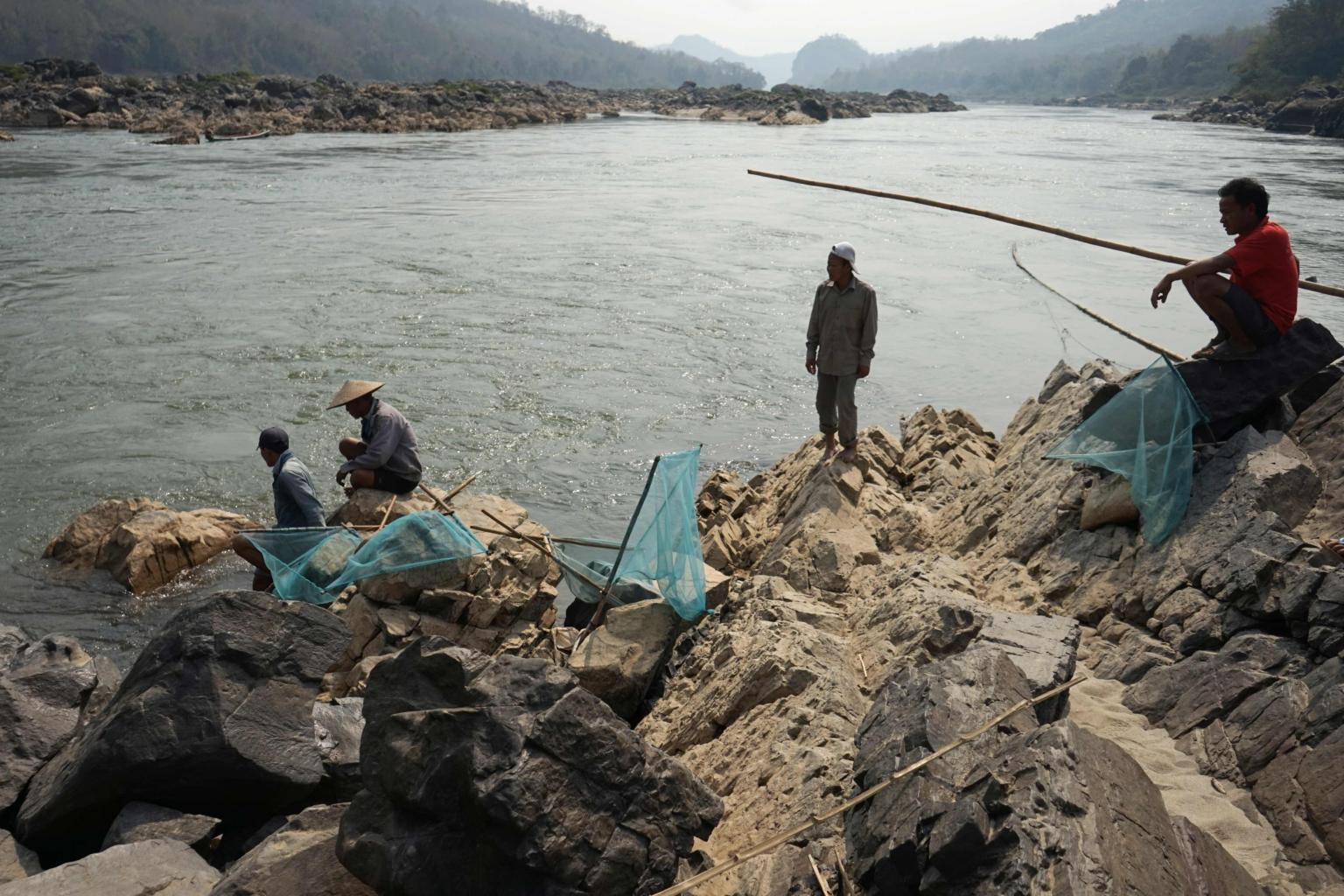The Asian Voice
China's BRI strategy and Laos: The Statesman contributors
In the article, the authors say that Laos is one of the top countries at risk of Chinese "debt trap" and should consider diversifying its investments with other countries - such as Thailand, India, and Japan.
Sign up now: Get insights on Asia's fast-moving developments

A photo from Feb 8, 2020, shows fishermen laying their nets on the Mekong River close to the site of an approved Laos dam site.
PHOTO: AFP
Nehginpao Kipgen and Megha Gupta
Follow topic:
NEW DELHI (THE STATESMAN/ASIA NEWS NETWORK) - Despite Covid-19 ravaging almost the entire world, China has continued to push forth its Belt and Road Initiative (BRI), taking advantage of the vacuum created by the months-long pandemic.
Among Southeast Asian countries, Laos, a tiny and an underpopulated state, has been one of Beijing's major aid recipients.
In return for granting loans and aid to Laos, Beijing has three basic demands: backing of the Chinese policy on issues such as Taiwan and Tibet; Chinese companies to be able to exploit Laos resources, and lines of communications to run through Laos to Thailand.
Laos has not only accepted these demands but has also let China be its largest investor. Beijing has pumped in billions of dollars into sectors such as hydropower, agriculture, mining and construction, all in all, for its larger "new silk road" strategy.
The construction of the China-Laos railway for the BRI, began in December 2016, involving six Chinese contractors with the plan of finishing the project in December 2021.
The railway line, which runs 414 kilometres, stretches from the northern-most district of Laos, Boten, bordering China, to the capital Vientiane.
The line will further connect with Thailand to Malaysia and Singapore as part of the Pan-Asia railway which will eventually run north-south from Kunming in Yunnan province to Singapore.
In light of the pandemic, China has strategically optimised the construction of this connectivity project.
However, the means adopted have not been the most ethical.
The personnel available for the construction is almost half - due to the pandemic - having to perform multiple roles in the scorching May heat.
Furthermore, the local staff who are obligated to stay at home due to the countrywide lockdown imposed in Laos are reportedly not getting paid for three to four months for a nearly completed project.
Another BRI significant project the Laos government has ventured into is the construction of the seventh largest dam on the Mekong river.
The currently operational Xayaburi and Don Sahong dams will now be joined by the 684-megawatt Sanakham dam, with the project completion date of 2028.
The proposal for the completion of the Sanakham project was submitted on 9 September 2019 by the Laos government to the Mekong River Commission (MRC).
As per the proposal, the dam will be built 155 kilometres north of Vientiane in the district of Sanakham. However, the proposal faced significant backlash as the construction of the dam will further gag the already encumbered Mekong river, a significant artery in Southeast Asia.
The existing dams have by now negatively affected fisheries, farms, livelihoods and riverbanks downstream.
Nonetheless, Beijing has continued to push forth the project. As a result, several environmentalists have urged the government of Laos to not proceed with the construction of another "destructive" dam on the Mekong river. "Sanakham dam should not be built at all.
There are several cheaper, less destructive and faster ways to meet the Mekong region's energy needs," said Pianporn Deetes, Thailand and Burma campaigns director at antidamming group International Rivers.
Despite facing these human rights and environmental issues, the government of Laos has committed itself to submit to China's growing influence in the region and around the world.
What shoud Laos do? Perhaps, Laos could consider diversifying its investments with other countries - such as Thailand, India, the United States and Japan - and not just depend on one single country.
Consistent engagement with China could potentially allow Beijing to have an easy hold over them and become a tool to push through their own strategic interests.
Better done now than later, as some analysts have said that Laos is one of the top countries at risk of Chinese "debt trap", albeit making it susceptible to fiscal independence and inability at diversifying its foreign relations.
While engaging in projects with other countries, Laos should keep in mind not upsetting its neighbours such as Thailand as well as consulting its local population and environmental groups on these crucial decisions.
Laos went ahead with the Xayaburi dam project with China, despite local protests from Thai villagers. In a bid to become the "battery of Southeast Asia", Laos cannot and should not get away with local consultation.
Lastly, the revival of Mekong River Commission (MRC) has now been overshadowed by the Chinese LacangMekong Cooperation Framework.
MRC is a novel initiative launched in 1995 in cooperation between Cambodia, Laos, Thailand, and Vietnam aiming to manage the river and its resources.
In 2010, they urged a ten-year moratorium on large hydropower dams, keeping in mind the best interests of the region. However, it has been unable to enforce its own recommendation.
Taking advantage of the situation, China launched the Lacang Mekong Cooperation Framework, to foster its BRI.
As China's geopolitical weight grows, susceptible countries like Laos, Sri Lanka and Djibouti should give a closer look at the Chinese strategic projects in their respective countries.
The writers are, respectively, Executive Director at the Centre for Southeast Asian Studies (CSEAS), Jindal School of International Affairs, O.P. Jindal Global University, and a Research Assistant at CSEAS and Director of South Asia Programme at The International Scholar. The Statesman is a member of The Straits Times media partner Asia News Network, an alliance of 23 news media entities.

